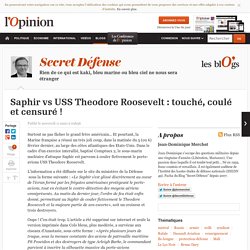

Saphir vs USS Theodore Roosevelt : touché, coulé et censuré ! Publié le Surtout ne pas fâcher le grand frère américain...

Et pourtant, la Marine française a réussi un très joli coup, dans la matinée du 5 (ou 6) février dernier, au large des côtes atlantiques des Etats-Unis. Dans le cadre d'un exercice interallié, baptisé Comptuex 2, le sous-marin nucléaire d'attaque Saphir est parvenu à couler fictivement le porte-avions USS Theodore Roosevelt. L'information a été diffusée sur le site du ministère de la Défense sous la forme suivante : «Le Saphir s'est glissé discrètement au coeur de l'écran formé par les frégates américaines protégeant le porte-avions, tout en évitant le contre-détection des moyens aériens omniprésents.
Au matin du dernier jour, l'ordre de feu était enfin donné, permettant au Saphir de couler fictivement le Theodore Roosevelt et la majeure partie de son escorte», soit un croiseur et trois destroyers. Oups ! Quoi qu'il en soit, bravo à l'équipage du Saphir ! Winning The War Of Electrons: Inside The New Maritime Strategy. A Navy electronic warfare technician.

[UPDATED with comments from Rep. Randy Forbes, Cdr. Bryan Clark, & anonymous admiral] WASHINGTON: We must win the war of electrons in a more dangerous world. That’s the stark imperative behind the bland title of the new maritime strategy released today by the Navy, Marine Corps, and Coast Guard. “There is an offensive warfighting tone to this document that says, where the United States has interests, it needs access, [and] it can have that access,” said the new Commandant of the Marine Corps, Gen.
Marine Commandant Gen. Despite its benign title — “A Cooperative Strategy for 21st Century Seapower” — and plenty of boilerplate, the new strategy has a definite edge. What does that mean? Elevating all-domain access to a fifth core mission is not merely a rhetorical flourish. That means All-Domain Access will take on new importance in the budget. Rep. Greenert’s Legacy And The Budget Adm. “This will very much institutionalize the initiatives Adm. Cdr. Cyber Subs: A Decisive Edge For High-Tech War? A US Navy attack submarine enters Apra Harbor in Guam.

THE FUTURE: Imagine you’re a Chinese high commander, taking stock at the outbreak of the next great war. All your aides and computer displays tell you the same thing: For hundreds of miles out into the Western Pacific, the sea and sky are yours. They are covered by the overlapping threat zones of your long-range land-based missiles, your Russian-made Sukhoi aircraft, your home-grown stealth fighters, and your ultra-quiet diesel submarines, all cued by your surveillance network of sensors on land, sea, air, and space. The net effect is what the West calls Anti-Access/Area Denial (A2/AD) and you call counter-intervention. Now you can deal with the Japanese imperialists and Taiwanese separatists without American interference.
Then it all starts rotting from the inside out. Here and there, in patches, your sensor coverage goes fuzzy, communications become erratic: American jamming. Vice Adm. Army Grapples With Cyber Age Battles In Megacities. High-tech warfare at knife-fight ranges: that’s the ugly future of urban combat.

If you thought Baghdad was bad, with its roughly six million people, imagine a “megacity” of 10 or 20 million, where the slums have more inhabitants than some countries. Imagine a city of the very near future where suspicious locals post every US military movement on Twitter with digital photos and GPS-precise coordinates. Imagine roadside bombs that fly because the bad guys downloaded blueprints for a kamikaze mini-drone and built it with their 3-D printer. As the US pulls out of the mountains and deserts of Afghanistan, the Navy and Air Force may be looking to the wide-open Pacific, but the Army is increasingly concerned about the cramped alleyways of Third World cities.
(The Marines, as usual, have a foot in both worlds). “We talk about the danger of failed states: Imagine a failed megacity,” offers Col. Nor is the problem going to wait for 2035. Inside the New Arms Race to Control Bandwidth on the Battlefield. An electromagnetic mystery in northern Iraq changed the course of Jesse Potter’s life.

A chemical-weapons specialist with the US Army’s 10th Mountain Division, Potter was deployed to Kirkuk in late 2007, right as the oil-rich city was experiencing a grievous spike in violence. He was already weary upon his arrival, having recently completed an arduous tour in Afghanistan, which left him suffering from multiple injuries that would eventually require surgery. In the rare moments of peace he could find in Kirkuk, Potter began to contemplate whether it was time to trade in his uniform for a more tranquil existence back home—perhaps as a schoolteacher.
Of more immediate concern, though, was a technical glitch that was jeopardizing his platoon: The jammers on the unit’s armored vehicles were on the fritz. Jammers clog specific radio frequencies by flooding them with signals, rendering cell phones, radios, and remote control devices useless. The Battle for Spectrum Dan Matutina.